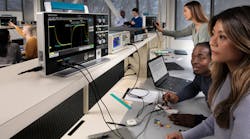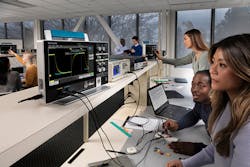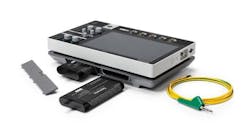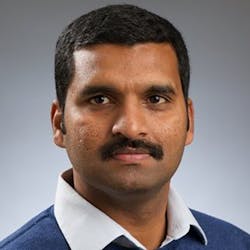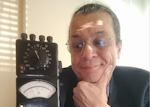This article appeared in Electronic Design and has been published here with permission.
What you’ll learn:
- What capabilities does the 2 Series mixed-signal oscilloscope offer?
- Advantages to using the 2 Series MSO.
- Thoughts from the company on the new oscilloscope.
Able to go seamlessly from the bench to the field and back, the new 2 Series mixed-signal oscilloscope (MSO) developed by Tektronix expands what’s possible in test and measurement by going beyond traditional workflows.
Weighing less than four pounds and about 1.5 in. thick, the 2 Series MSO is truly portable, enabling engineers to achieve things not possible with legacy solutions (Fig. 1). With a variety of integrated options, the 2 Series MSO can take two or four analog channel inputs. It's equipped for advanced debugging at bandwidths from 70 to 500 MHz with a 2.5-Gsample/s rate.
The MSO’s 10.1-in. touchscreen display eases operation, and the built-in capabilities of the optional arbitrary function generator (AFG), pattern generator, voltmeter, and frequency counter provide functional versatility in a single instrument. When used with batteries, the Series 2 MSO can function for up to eight hours (Fig. 2).
We reached out to Tektronix’s launch lead product developer, Prashanth Thota, to talk about the new MSO and what it means to the engineer:
This advance leveraged your Growth Accelerator process and was created by your working closely with electronic and mechanical design engineers. How challenging was that? Was it difficult to aggregate and integrate that much information from such diverse sources?
Tektronix, which is part of Fortive, uses the Growth Accelerator process for product conceptualization and development. The toolkit enables us to understand the market segments we intend to serve, the problems that customers face in these market segments, and identify products with the right mix of features that addresses customer needs.
The toolkit we use for this process makes what could be a very difficult or challenging process, systematic and informative. It provides an organized structure to a complex system of development, helping us learn and develop a product that is truly desired in the marketplace.
Work is performed in what is called Build Measure Learn (BML), whose cycles are iterative in nature. Usually, each BML cycle is six weeks long. The team, which includes representatives from marketing, hardware, mechanical, field-programmable gate array (FPGA), software, and operations, meets and sets goals for each BML. The goals are selected in a way in which insights are contributed from each team and come together to enable a customer-visible feature.
The features (or “Builds”) from a BML cycle are tested with the customers to validate the performance and usability (“Measure”). The results (“Learnings”) are then applied for refinement in future BML cycles.
This process also allows us to focus on critical goals that need to be achieved in smaller increments, followed by refinements based on lessons learned. In this way, a great deal of information can be aggregated from diverse sources to build a truly unique product.
One of the things you point out is the need to test and evaluate integrated systems. The high level of system integration in the 2 Series MSO reflects this itself. However, it is important for test equipment to be more precise than the devices they test. How did you test the testers?
Tektronix uses precision test equipment such as the Fluke Scope calibrator to calibrate the 2 Series Mixed Signal Oscilloscope. Tektronix certifies that each instrument is calibrated using standards that are traceable to the National Institute of Metrology and the procedures used for calibration also comply with ANSI/NCSL Z540 standards.
Quality, reliability, and safety testing such as shake, shock, vibration, humidity, atmospheric, and drop tests are also performed to ensure the performance of the product. The product is CSA-certified for safety.
Tektronix is accredited and has in-house labs for these tests, enabling us to perform extensive testing that results in a safe, reliable, and accurate product. Through our service organization, we also offer various calibration and protection plans to ensure that the product operates within its defined parameters through regular calibration for years to come.
How much of a balance of hardware and software do you feel is presented in the 2 Series MSO? Considering the user interface, for example, which leverages advanced touchscreen hardware with the system software, which aspect do you feel is becoming the most critical?
I believe the hardware and software are equally presented in the 2 Series MSO. They come together to offer a full-featured scope in a compact, portable form factor that’s easy to use. Customers are looking for three aspects of a product: flexibility, ease of use, and data sharing or collaboration. The physical product that includes industrial design, mechanical, and hardware engineering enables flexibility.
The 2 Series MSO is a compact, lightweight, and portable instrument with a removable battery pack that offers freedom to test in the lab or out in the field, a very stable stand with various configurations for many applications, a VESA mount that offers multiple mounting options, a simplified membrane switch front panel with integrated ring lights for a great tactile feel, and a large touchscreen display for signal viewing and analysis.
The software platform layered on top of the physical product brings everything together by offering an interface that allows users to quickly accomplish their task. It also enables complex analysis and data-sharing needs that have increased over the last few years with the hybrid working environment.
Do you feel that collaborative design capabilities are becoming more important in product development and manufacturing?
Collaborative design capabilities are becoming increasingly important as teams must optimize the trifecta of cost, performance, and time to market. The last few years have brought an additional emphasis on collaboration as teams battle the current market dynamics. For example, the hybrid/remote work culture that started during COVID has become increasingly mainstream, leading teams to develop innovative ways to work and rely on new tools to collaborate.
Competing priorities require collaborative part selection to ensure target performance, ease of integration, cost goals, availability, and need to be with thermal and power budgets.
Worldwide product sales require close collaboration between teams in different regions to ensure coordinated marketing campaigns and adequate supply. Product compliance and safety standards vary by region/country, resulting in the need to track these standards and ensure that the product meets these standards, enabling sales worldwide.
The 2 Series MSO also can be battery powered. How does that work and how long do the batteries last?
Yes, the 2 Series MSO was designed to have an optional detachable battery pack for the subset of customers who will want this feature. Those who do not need the battery option will have an even slimmer and lighter instrument. The battery pack has two slots for batteries. With two fully charged batteries, the battery life is eight hours, which can be hot-swapped for unlimited time on battery operation.
Now, customers can use the instruments in the lab where they have access to power, and in the field where there’s no access to power. The slim, lightweight design of the 2 Series MSO with the battery pack mounted to the back of the instrument is perfect to take an instrument wherever needed.
The MSO also has natively integrated software tools to allow engineers to collaborate, troubleshoot, and debug designs across time zones. It also includes TekDrive, our test and measurement data workspace in the cloud that enables engineers to upload, store, organize, and share any file they or anyone else makes from a connected device.
Users can also perform analysis on a waveform and save it back to the cloud for immediate viewing and feedback.
For more information on the Series 2 MSO, click here.
